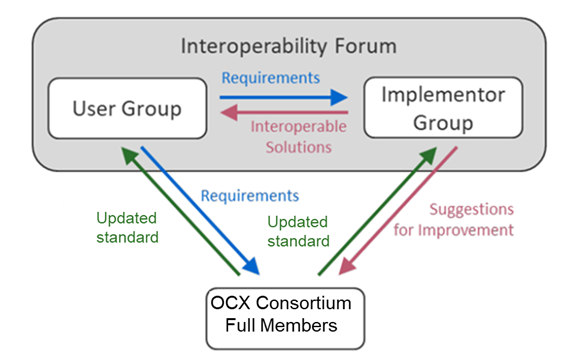

Way of working
The OCX-IF is a three-party relationship between the Implementor Group, the User Group and the Standards Community:
- A User Group representing the end users
- An Implementor Group consisting of companies developing SW support for the OCX standard (CAD vendors, classification societies or PLM consultants)
- The Standards Community = OCX Consortium Full Members
OCX-IF User Group
The User Group consists of maritime industry end-users (typically designers and shipyards) who define and prioritise industry requirements, test cases and acceptance criteria for OCX capabilities in the scope of the standard.
Objectives of the OCX-IF user group are:
- Manage industry requirements for interoperability.
- Convey capability gaps to standards bodies
- Create & maintain common industry Use Cases and associated Test Cases
- Prioritise a list of Use Cases for test rounds by the Implementer Group
- Allocate industry requirements to interoperability validation & verification with KPIs
- Review the scope of the OCX Recommended Practices with industry needs
- Create user best practices for OCX exchange
- Communicate to the outside world
- Conferences, Show Cases etc.
- Present pilots (showcase, etc.)
- Promote results and usage of the OCX-IF
OCX-IF Implementor Group
The main deliverable of the OCX Implementor Group is interoperable OCX software products. This is enabled by harmonised implementation guidelines for the OCX standard, the so-called Recommended Practices.
The Recommended Practice documents:
- harmonised approaches for realising specific capabilities in the OCX standard, based on users’ requirements
- are the foundation for the consistency and interoperability of OCX interfaces
- provide comprehensive implementation guidelines with examples
- get validated in Implementor Group test rounds
- are publicly available on the OCX-IF homepage after successful testing and release.
OCX-IF Test Round

The Recommended Practices are validated in OCX-IF test rounds. During each test round:
- participants provide OCX files based on the OCX schema, Recommended Practices and test case definitions
- files are tested for syntax and structure, including conformance to the Recommended Practices
- statistics are gathered and evaluated to determine the success rate for each test
- technical issues are openly discussed in an atmosphere of trust to derive recommendations for improvement of
- The OCX interfaces
- The Recommended Practices
- The OCX standard itself